When we first hear “Oaxaca”, many of us think of mezcal. A beautiful, clear spirit, rich with flavor. This richness comes from a diverse terroir that informs both the agave as it grows and the process of production.
An essential element of this terroir is the water that nourishes it. On average it takes 10 liters of water to make one liter of mezcal. Almost 72.3 million liters of water were used to make the mezcal exported to the US in 2023. Water is a resource that is becoming less reliable in Oaxaca, raising concerns for agave growers, mezcal producers and everyone else besides.
Water security is described by the World Water Council as the “availability of water, in adequate quantity and quality, to sustain social and economic sectors without exceeding its ability to renew.”
Crisis in the city
Oaxaca is no longer at a point of preserving water security, but tackling water scarcity. So far 2024 has had record breaking temperatures, wells are empty and the Sierras are ablaze. Smoke over Matatlan is no longer just from mezcal production, but pours from heartbreaking forest fires. Notably the fire in San Lucas Quiavini that raged for days, killing five local men.


The iconic aqueduct in Oaxaca City, stands dry as a bone, a monument to when water flowed more freely to the city. However, recently the city has been congested with blockades. These are in protest of the lack of public water delivery, a service provided by SOAPA (Drinking Water and Sewage Services).
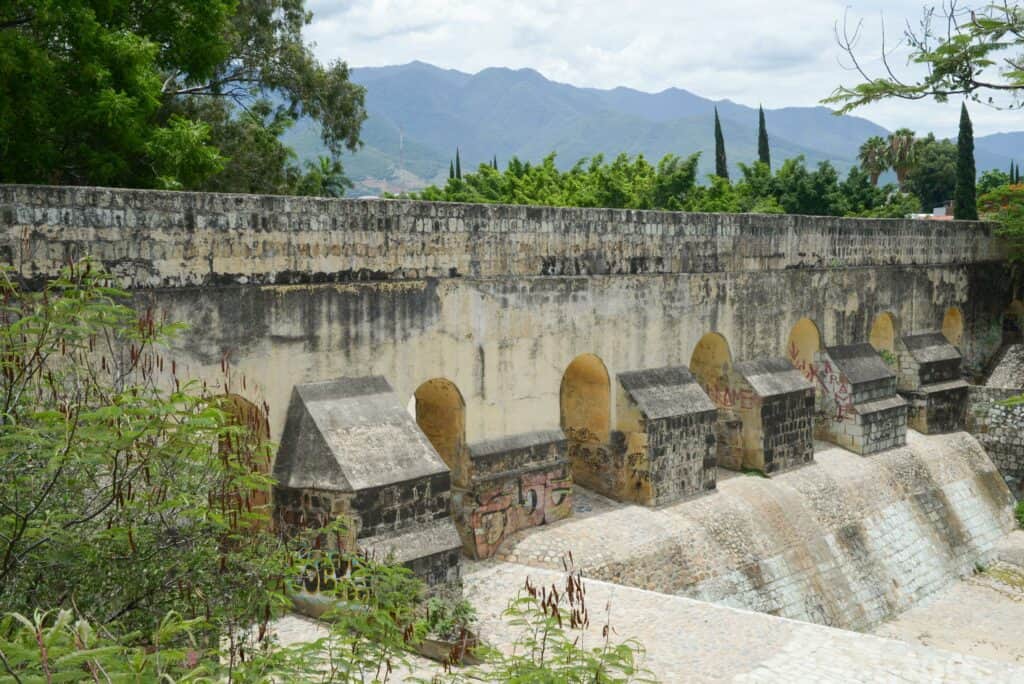
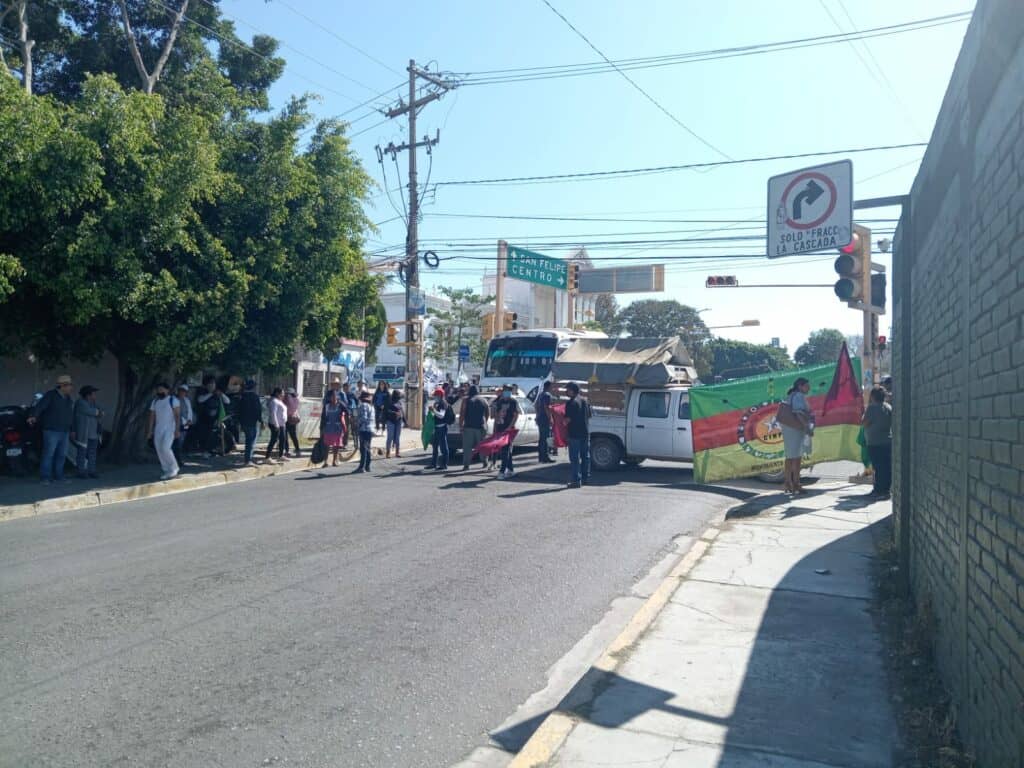
Omar Perez Benitez, director of SOAPA, says that Oaxaca is experiencing a water crisis due to an extremely low water table and failing wells. Currently there is approximately a fifth of the necessary water needed to supply the city.
Normally water comes every couple of weeks. In our neighborhood the recent gap between deliveries was seven weeks making it one of 26 colonies reported to be “red light” as water is arriving less than every 40 days. The neighborhood is called Martires del Rio Blanco (white river), but it has been a long time since there was a river flowing.
Environmentalist Nasario Garcia explains that the river flowing from San Felipe is almost completely dry. Five years ago it was a principal source of water. He blames a lack of commitment from the government and indifference from society as a whole.

Climate Change no doubt is a major factor to the water scarcity in Oaxaca. However, there are further contributors that should be acknowledged. Urbanization and gentrification have put increasing pressure on what is an outdated system, with services like AirBnB behaving ignorant to the concerns. Hotels and wealthy businesses receive a disproportionate amount of water at the expense of local people.
Many believe the current situation is due to a mismanagement of the resources available. Speaking to Francisco, the head of our neighborhood council, he thinks the issue lies “directly with the state government. That is why the blockades occur because they have not been able to supply the water shipment well. They make many excuses, like leaking pipes.” He thinks there are solutions but that “the water people have not wanted to provide them.” Now more people are shelling out for private trucks to bring water, despite still paying service bills for water that is not coming.
At midnight on the second of January the gravity of the situation arrived at my door with a bang. I woke to a 22,000 liter water truck (pipa) crashing into the side of my car, which was parked outside my home. Like much of Oaxaca, my road is very steep, and in the years living here I have never seen a truck of this size attempt the climb. The timing also seemed suspicious – water deliveries in the middle of the night?.

My feelings are reflected in the increasingly frustrated notifications about these trucks that block the narrow streets of Oaxaca as more and more people lean on these private, and unregulated resources. Some of the most concerning posts describe these “pipas” scamming locals, and pumping water illegally from local wells, reservoirs and polluted sources.
Primerlinea.mx reported that over 30% of the water problem is due to the theft of water by “huachicoleros.” They are taking the water from wells, reservoirs and tanks that are meant to supply the public water services.
A friend based in San Agustin, Etla (40 minutes from Oaxaca City) describes seeing military guarding the local reservoir, a major source of public water to the capital. San Agustin, Etla is typically considered a lush area, but recently there have been reports of 80 to 100% crop loss in the surrounding area due to drought.
There have also been photographs in the local news showing pipas pumping water from the Atoyac river. “Pipe workers from Oaxaca have been denounced because, due to their greed for money, they are extracting water from the contaminated Atoyac River to sell it, putting the lives of Oaxacans at risk.” (Agenda Mediatica). Considering banks of the river have also been used as a temporary dump, due to overloaded landfill sites, it is scary to think water is being pumped directly into trucks and distributed for human use.

The overall quality of water in Oaxaca
Water contamination is also a serious concern, both for sourcing water for the city and for agricultural uses. “Seventy percent of our water in Mexico is contaminated to some degree,” said Ricardo Ovando, an activist with the nonprofit Agua Para Todxs (Water For All). He believes that it is due to the 1994 North America Free Trade Agreement (NAFTA). This law removed control from local and municipal authorities, allowing the privatization of essential services.
NAFTA enabled more industrial farming in Mexico to be developed for export to the US. These ‘farms’ use huge amounts of water, alongside fertilizers and chemicals that create runoff into the surrounding water table. Ovando explains that this law also created a free market around water which “was an enormous boon for industry, but it has wreaked havoc on local water supplies.”
Speaking to friends in Oaxaca, there is also discontent surrounding the carelessness of big industries such as CocaCola and local mines.
Mining companies, such as the Fortuna Mines near San José del Progreso, Oaxaca consume and pollute water resources. These companies are drilling for gold and silver over thousands of hectares. Runoff known as “tailings” from the mines pollute water downstream in areas like Ocotlan.
Fortuna claims that these tailings do not pose any danger to the environment or to the health of nearby populations, even though they are the result of a process in which a range of toxic chemicals are used.
In October 2018 there was heavy rainfall. According to Fortuna, this caused the pool that captures rainwater and tailings to overflow. Mexican authorities’ wrote that “the pool’s two pumping systems were not sufficient to pump this water to the tailings dam, which caused the water to overflow.” (nacla.org)
Communities declared serious negative impacts to their territory. They found the gray sludge in water they used for plants, animals and to drink. Animals began to die and people reported stomach problems, rashes and outbreaks of hepatitis. They drank bottled water for a time, but this was financially unsustainable.
The National Water commission Conagua took samples of the local water and had it tested by two national laboratories: “The presence of metals also meant that the water failed to meet the country’s quality criteria for agricultural irrigation and livestock uses. In the El Coyote stream, iron exceeded the permissible limits by up to 1845.8 percent, aluminum by 955.12 percent, silver by 591.2 percent, nickel by 173.915 percent, and lead by 167 percent.”(nacla.org)
Despite mining being broadly illegal in Oaxaca, there are still groups continuing the practice based on pre-existing mining concessions. On May 28 2022, militants attacked communities in San Pablo Venado, Oaxaca. Speaking with Edu Oaxaca the community stated: “It is clear that they want us to leave here to make way for mining projects, for the sale of lots for homes, so that they can exploit the water and the forest.”
Water, agave, and deforestation
Industrial practices in mezcal are also a concern. Clearing forests, runoff from fertilizers and disposal of viñasas are a few of the practices that can negatively affect the local water systems. However, speaking with agroecologist Vinik Juré, the impact is comparatively small alongside mines and soda companies.
Oaxaca is known for a rich history of agave farming. This plant is famously drought resistant, so as drought persists (and the mezcal market grows), there has been a move from mixed crops to planting only agave. Although this is a valuable crop, the lean towards monocrop practices with espadin is a growing issue. It leads to the clearing of biodiverse forest to grow agave, which in turn creates problems with water runoff and is a major contributor to rising greenhouse gasses.
Recently I was driving with Darinel Silva through the mountains of Oaxaca and he was moved to point out the bare looking patches on the distant hillsides. At closer glance they are square fields of espadin, cut out from the forest. Deforestation is among the detrimental results of producing enough agave to fulfill the demand for industrial scale mezcal production.

Speaking with Sal Palacio, whose family produces Mezcal Salvadores, he explains that in the last ten years they have seen an increase in housing, including the migration from smaller pueblos in his home of Tlacolula, about 45 minutes from Oaxaca City. He is also concerned by the impact of “big companies such as Armando Prieto destilería that are using a lot of the water”.
He remembers that “in 1993-1995 (his) mom was working as the Regidora de Agua potable in the Tlacolula municipality. She was the only woman dealing with more than 150 male workers on the project.” Their work was to clean up the existing well and increase the size of the pipes so the town could have city water. “But our little town is now a major economic destination for other small towns. A lot of people migrated to Tlacolula” So now the infrastructure is insufficient for the demand, much like in Oaxaca city.
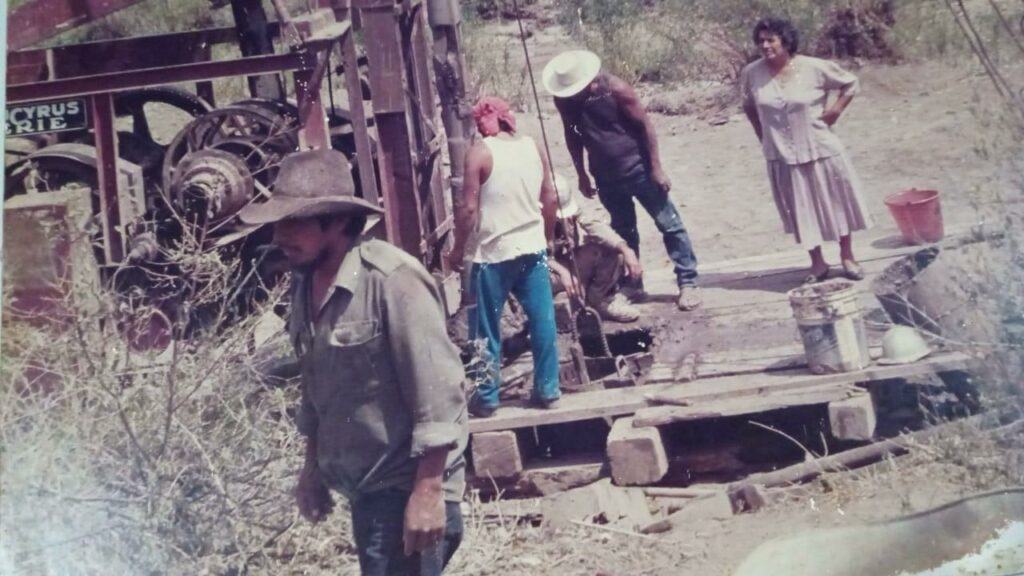
Looking to the future Palacios thinks that “we need more companies, small and big, to come together for a common goal. We need to have more reforestation. Our plan is to collaborate with other mezcal brands or other local businesses. Last week I met Samuel from Mezcal Los Ocotales in San Dionisio Ocotepec. They plant 1000 plus Ocote trees every year. We want to support this effort.”
The case for reforestation in Oaxaca
Speaking with Vinik about the value of work like this, he explains how reforestation helps replenish the water table. More trees help water percolate into the ground, regenerating water security. When you have a cleared landscape it is vulnerable to erosion and water just runs off, stripping the soil further. The more time it takes for water to pass across a surface the more likely the water will penetrate the soil.
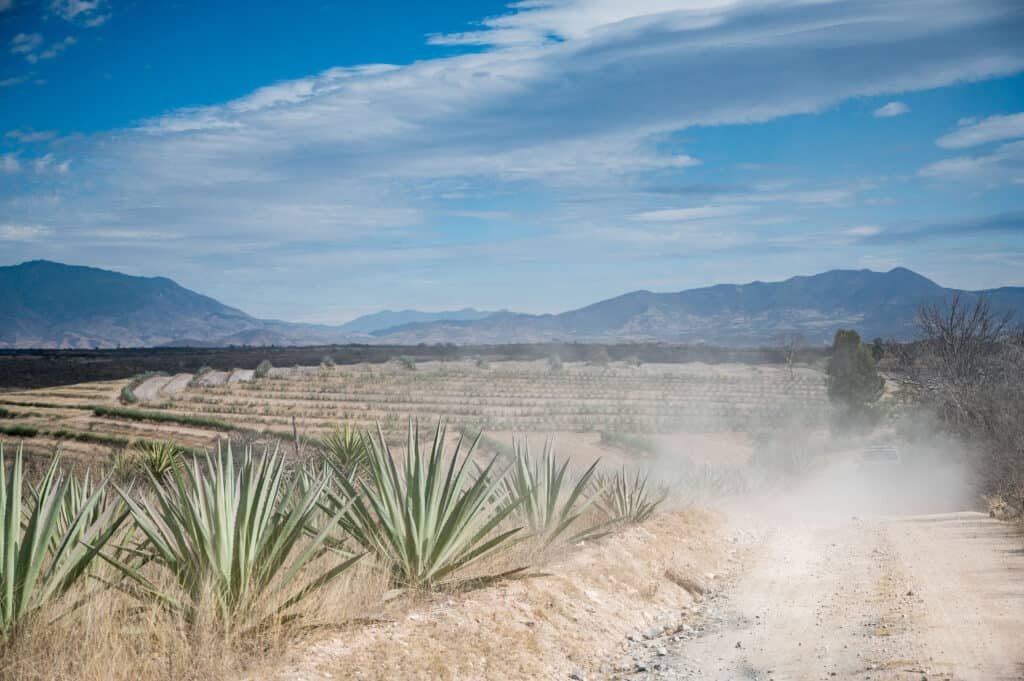
According to Professor David Hannah, who holds the UNESCO Chair in Water Sciences at the University of Birmingham “We need to be designing forests and agricultural systems that embrace and enhance diversity. This approach is essential if we are to preserve the natural resilience of our water-dependent ecosystems and provide better stewardship of the Earth’s finite water resources.”
David Ellison from the Institute for World Economics says “Growing trees take water from the soil and release it into the atmosphere. Tree leaves also act as interceptors, catching falling rain, which then evaporates causing rain precipitation elsewhere — a process known as evapotranspiration. By better understanding this process, we may, one day, be able to strategically plant trees that will bring rain to regions that need it most. As the climate changes, severe droughts are likely to become more common, and we shouldn’t miss the opportunities to influence the hydrologic cycle in a beneficial way using trees,”
Samuel Santiago Mendes from Mezcal Los Ocotales explains that trees support water security in several ways: ‘evapotranspiration’, ‘Vapor release’ when trees release small amounts of vapors called sesquiterpenes, which contribute to cloud formation and a process he calls the ‘Layer of cups’ where the tree crowns collect as much rain as possible. The rain slides between the leaves, branches and the trunk until it reaches the ground.”
As well as a vivero for wild agaves and endemic trees to reforest the nearby sierras, Ocotales is building a new palenque. This will run with alambiques de barro. All the water used in the palenque will come from rainwater. Some direct rainwater will be transported through a unique capture system incorporated in the innovative design of the space itself. Some from a rainwater capture system that will run year round. According to Samuel, if there is no rainwater the palenque will not run.

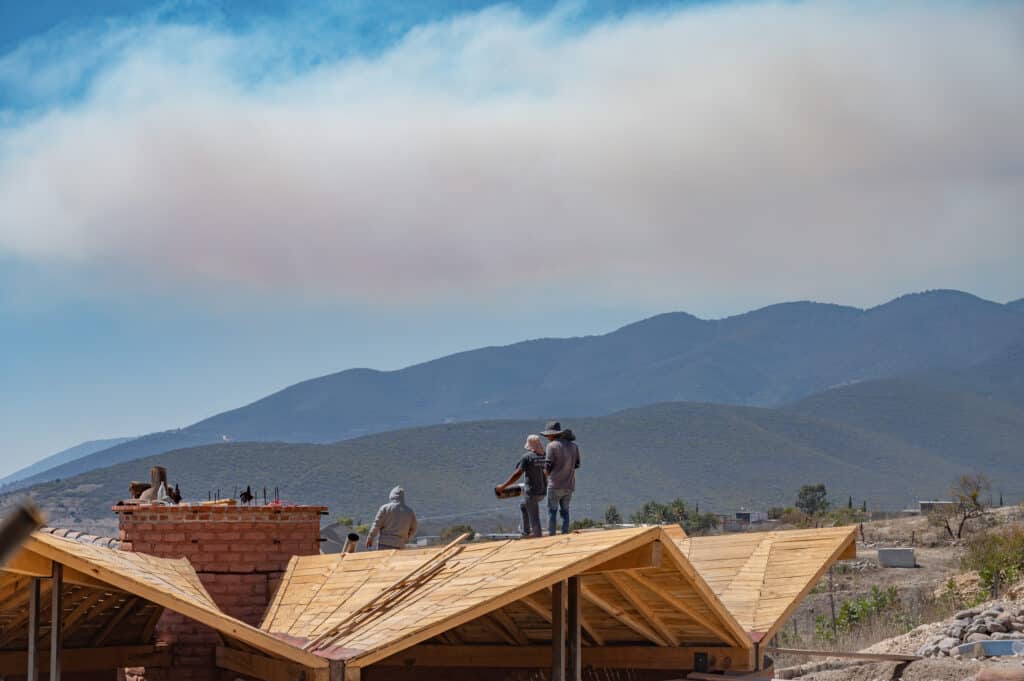
As mezcal is iconic of Oaxaca in the international market, it is heartening to find mezcal producers and brands such as Salavadores and Ocotales considering their impact on the water supply and looking to change things for the better. There are also those backing initiatives to support water security. For example Pensador’s collaboration with producers in San Isidro and Neta’s recent work with Isla Urbana (who also have a project with Lost Explorer mezcal) and the producers in Logoche.
Community-based solutions to Oaxacan drought
Ben Schroder, founder of Pensador Mezcal, notes that one of the key changes felt in recent years is the scarcity of water. “This has been keenly felt in the town of San Isidro Guishe. Wells have been diminishing, and ancient rivers have run dry. A consequence of both increased agricultural demand, and sporadic rainfall due to climate change. Many families have been reliant on water delivered by trucks – an expensive and unreliable dependency.”
In 2022 Schroder helped fund the building of a new well as a resource for the community of San Isidro. This was part of a broader project to develop a water management program in San Isidro Guishe. The project began in July 2022 as a meeting with the local community to share ideas. In September they began construction of a the well. The work was led by mezcalero Jose Garcia with consultation from Vinik Juré of Expresiones Bioculturales a research based Oaxacan NGO focussed on developing regenerative agricultural systems.
According to Schroder, next steps involve working with geologists from Mexico City specializing in water management. “They will analyze the state of the water table in Miahuatlán to give us a better idea of our current situation; information which will help us to develop specific solutions to the challenges faced.”
I visited the project in San Isidro in September 2022, where I saw them installing the new well. When I arrived at the project site with Vinik, the well was almost complete. A space had been excavated into the cliff side, and Jose and a team of local construction workers guided a digger to lower rings of concrete into a deep hole. One of the workers confidently climbed inside the hole between each drop to align the rings.

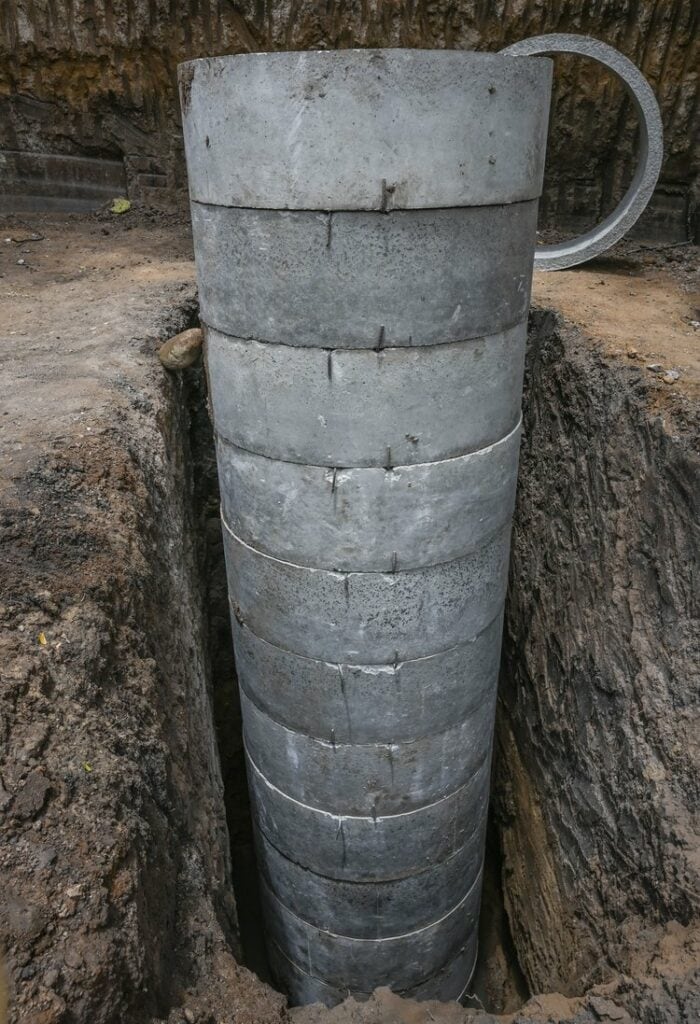
Reflecting on this experience, Vinink said “We built a well, but we accompanied the construction with planning for the future through an ecological restoration method called comprehensive basin management. Little by little we got to know each other, sharing experiences and knowledge.” He emphasized the need for listening and empathy. “Everybody has a unique understanding of how water should be managed.”
Speaking with Vinik, he explains how it has been over “sixty years since the advent of plumbing and water pumps.” During this time people have become accustomed to over extracting water because it is easy.
Vinik describes that the biggest challenges implementing water projects are people’s perspectives. How they might see water as a resource, a right, to be used, shared, bought or sold. The issue is social as well as environmental.
According to Vinik, our action is to overuse water, the environmental impact is the limited access to water. Then “this social repercussion is that people are living with poor water security. We don’t have enough water to cover our basic needs.”
Discussing solutions to the crisis, Vinik thinks that we need to change people’s mindset to be more autonomous. “In rural communities they recognize that to be autonomous is better.” There are state and nationwide actions that are required, but we need to take responsibility at a personal level. Waste less, save more.
“It’s a response on different levels and we can do things on different levels, make our own dry toilets, for example, our own constructed wetlands in a collective level, we can do it in our neighborhoods. But also we should be asking the government about this situation and institutions as well.”
On a statewide level Vinik believes that big agriculture should be prohibited and that urban planners should be more considerate. “Let’s make our cities like sponges again.” On a personal level Vinik talks about changing to compostable toilets so we aren’t flushing away clean water. Avoiding industrially produced food. Building rain catch systems.
Most of the mezcaleros I know say they try to save or recycle water at some point in their process. NETA is currently working on a new project with a team of mezcaleros to save rainwater.
NETA which translates loosely to ‘truth’ or ‘are you serious’ is a brand that works closely with over twenty small, family producers from the southern valleys and hills of Miahuatlán, Oaxaca. They are proud that “no two productions they bottle will ever be exactly the same as environmental conditions, water, natural yeasts, and soil types all contribute to their nuances just as much as the touch of their maker.
One of the communities they work with is the village of Logoche, an area renowned for its delicious mezcals. Logoche operates under two distinct systems: federal governance and indigenous customary laws known as Usos y Costumbres. The latter empowers direct community involvement in the welfare of all and land stewardship.
NETA says that every producer family has access to wells on their lands, from which they draw water for their viveros, fermentation and mezcal distillation. “A typical seedbed in Logoche, home to 3,000 plants, demands around 3,600 liters of water per week, the process of fermenting 10 tons of raw agave requires approximately 7,000 liters of water, a ratio of 1kg of agave to 1 liter of water, mixed in fermentation vats or tanks with capacities ranging from 800 to 1400 liters.”
“The cooling phase of distillation relies on well water, as each producer’s well supplies the necessary water. An estimated 15,000 liters of water are used during the distillation of 10 tons of agave. Cooling tanks are initially filled and emptied as needed throughout distillation, with capacities ranging from 4,000 to 5,000 liters of water.”
Speaking with Niki Nakazawa cofounder of NETA, she described how the Logoche Water Project came about as the result of an ecological impact report that they commissioned in summer 2023 from Selene Osorio, a sustainability consultant. This was done to quantify the inputs and ecological impact of mezcal production in the community. “During the survey and field work producers were unanimous in their response to the question about what the most pressing ecological issue is that they’re facing. And that was related to water security. So the aim was to present a holistic strategy to address water security in the community.”
Although so far no producers in the area use water capture systems there is overall interest in developing a scheme for this.
NETA has united forces with Isla Urbana, an organization dedicated to promoting sustainability through rainwater capture. Together they will build water cisterns to help store water in Logoche, accessible to the whole community. “Each cistern will have the capacity to hold between 15,000 and 25,000 liters per rain, amassing 307,200 liters annually.” Niki had been aware of the work of Isla Urbana for some time. “I was aware that they had been implementing rainwater capture systems in Oaxaca. So we talked and decided this could be a really good project.”
“This is really a pilot project. We’re experimenting with rainwater capture, hoping that it will rain sufficiently to allow us and members of the community to store enough water to sustain them at least partially during the dry months and to allow for the wells to rest. So the water that we’ll be capturing will be used principally for domestic use and watering plants in their agave nurseries. We’ll see if it’s successful and if folks are happy with these systems then it’s something that we could potentially look to replicate in people’s individual palenques and homes. We’re really just trying to experiment with as many different initiatives over the next few years to help combat this continuing drought. They have their own initiatives on the municipal level, on the community level and this water rainwater capture project is really just us putting our granito into that”
The team at Isla Urbana explain that “to achieve a rational, ecological and sustainable use of water, it is essential that we learn to take advantage of the largest and most accessible water resource that is currently wasted: Rain.”
Raising awareness – climate change
Recently in Oaxaca there have been numerous councils held to spotlight issues arising from climate change, including water scarcity. On March 6th a meeting was held between representatives of social organizations and citizens involved in environmental issues, academics and authorities from different municipalities. The focus was: “Oaxaca in the face of the climate crisis.” (Educa Oaxaca)
Oaxaca’s creative network is also speaking out on the subject. Members of the Milpa Urbana collective and ecological center, have been producing embroidery “to raise awareness about the use and care of water.” Edith Morales is a member of this collective – a space where various themes have been developed through embroidery. She stressed: “Without water there is no life.” (Educa Oaxaca)
Another collective making art to raise awareness for issues of water security, specifically around the aforementioned Atoyac river is ‘Hacer Tequio’. They run workshops for people to come and share their stories and reflect on the condition of the river. The group was first developed to strengthen biocultural identity and exercise cultural rights.
Tequio roughly translates to ‘community work’, work owed to support the community. In the current state of ‘climate crisis’, it is time to reflect on the actions we can take to support our community. Both our direct community and our wider world. Governing bodies owe it to their communities to make water security a priority. At a grassroots level we can all make changes and choices to conserve, recycle and celebrate the water we get.
As consumers of mezcal it is valuable to know about challenges faced at the source. Investing in brands that are engaging with the issues around water security will have positive results.
You can donate directly to Isla Urbana via paypal to info@islaurbana.org just make sure to include “Logoche Water Project” in the donation notes.




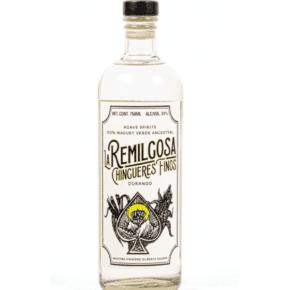








Anna, I really have a great concept to help these people save water. It was featured and tested by the LA Times. The water savers are called “sink twice”. They install in five minutes and can save each household huge percentages of water bringing lots of added water security. I’d love to help. I manufacture them and can of course scale up.
Amazing article. I am currently living in Oaxaca.